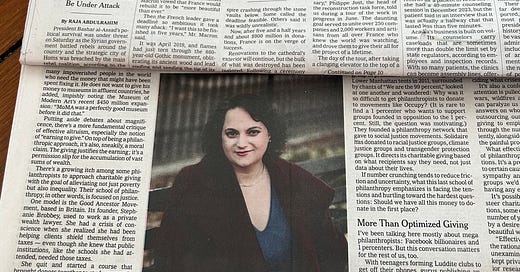There’s never a *bad* time to have your work featured in the New York Times, but this weekend’s article, “What if Charity Shouldn’t Be Optimized?” came at a particularly auspicious moment. (It also may have brought you here, in which case welcome!)
The reporter, Emma Goldberg, captured my ideas well. She honed in on the key proposal of the book: centering “magnificence” in philanthropy. The book goes into greater depth about this, but essentially “magnificence” means making beautiful, splendid, life-affirming spaces and activities available to everyone. It is about making the highest goods of life accessible to all, rather than the lowest common denominator of bare survival. This is not just some Romantic ideal, or a “let them eat cake art” approach. People of all economic status value and deserve sanctuaries, places they can FREELY access that are comfortable AND dignifying. Grand libraries, well-tended parks, and stunning cathedrals — like Notre-Dame de Paris.
And wouldn’t you know — the day “magnificent philanthropy,” as illustrated by Notre-Dame’s restoration, was highlighted in the Times was the very day the cathedral reopened for its first mass after the 2019 fire.
I watched the reopening ceremony this past Saturday, attended by heads of state and involving some killer vestments on the Laurent Ulrich, the Archbishop of Paris, that appear to be Twister-themed (???)
To be clear, I am here for it. Between this and Conclave I am increasingly Catholicism-pilled. All the Inquisitors had to do was bust out some bolder fashion choices, apparently.
One of the things I was looking for while watching was how this intensely French ceremony would acknowledge the importance of philanthropy in rebuilding the cathedral. French culture is much more subdued about money; its major donors try not to trumpet their giving, and in fact the big eight-figure pledges to Notre-Dame ended up backfiring, as they just underscored already-tense dynamics around inequality. (Note: all close reading to follow is based on translations of the French, feel free to write me if I’ve misinterpreted any language choices or missed nuances!)
Macron’s remarks skirted this topic. He dedicated much more time to celebrating the firefighters whose interventions limited the damage, and to the artisans and workers who did the very skilled labor of restoring the structure. (The scaffolding workers, the electricians, the woodworkers…”). He used a very particular French term of “fraternity” to describe the restoration’s donors — “thanks to an unprecedented fraternity, a fraternity that brought together people from all continents, people from all countries, from all classes.” Having immersed myself in French politics and its culture of giving, I can pretty confidently surmise that Macron wanted to talk about wealth and wealthy people as little as possible, because it would strengthen the (accurate) narrative that his government favors the elite.
Better, then, to use language that puts major donors on the same plane of importance as the laborers and firefighters, to emphasize the geographic and economic breadth of supporters rather than the extraordinary sums of the top gifts, to describe restoring the cathedral as a collective, solidaristic project. (This was slightly undermined by the camera cut to a donor recognition plaque that specifically names the Arnault, Pinault, and Bettencourt Meyers families and the major French corporations.)
In all seriousness, I do think it is good and right and refreshing that a ceremony like this honor artisans and firefighters above big-money donors, that it would focus on the history and significance of the cathedral, a space whose importance far exceeds that of any wealth-holder. I also think that in his efforts to appear democratic and egalitarian, Macron was almost too obvious in his efforts to downplay the financial generosity that funded all of that tremendous craftsmanship. Perhaps surprisingly, perhaps not, it was the man of God who did a better job acknowledging philanthropy as an expression of devotion to beauty, grandeur and the sacred.
Archbishop Ulrich had a wonderful line in his remarks that I transcribed in real time:
“This philanthropy is a manifestation of the desire to participate in the beauty of humanity.”
That, right there, is magnificence in action, as a guiding value. Participating in the beauty of humanity is an inclusive activity, one that ennobles all who engage in it. Much like the building of Notre-Dame itself, it is a reflection of how much beauty and splendor matter to those who are not rich. It is the people’s cathedral, and it affirms how much we all matter.
Notre-Dame’s reopening coincided perfectly with a major moment of visibility for my book, which celebrates it as a paradigmatic example of how philanthropy can connect us and affirm our humanity at the highest level. I am very moved and happy about that. I also want us to honor and hold onto that serendipity, to return to this moment as we make giving decisions this year and in the years to come, that beauty and magnificence are a way of preserving and sharing the best of humanity.





